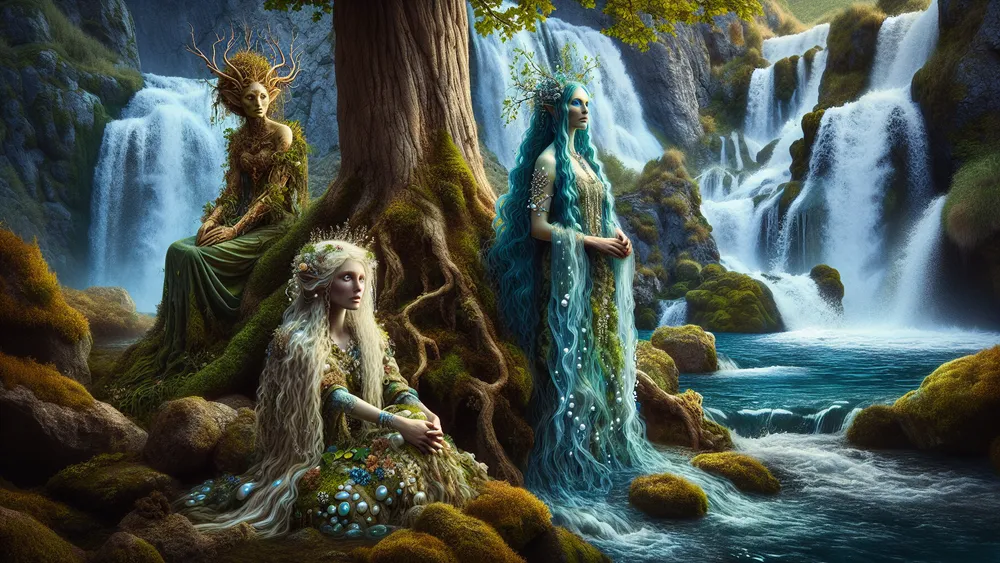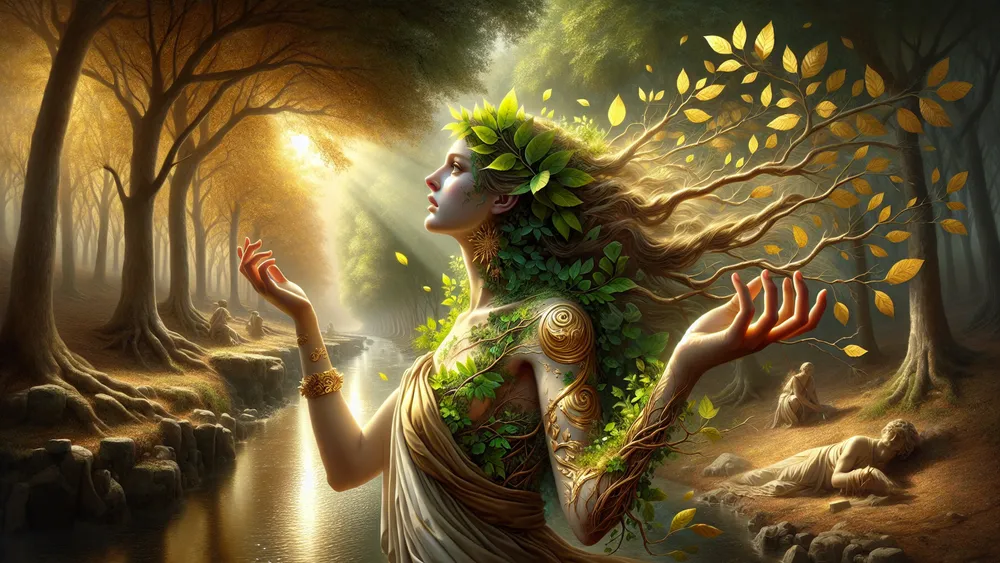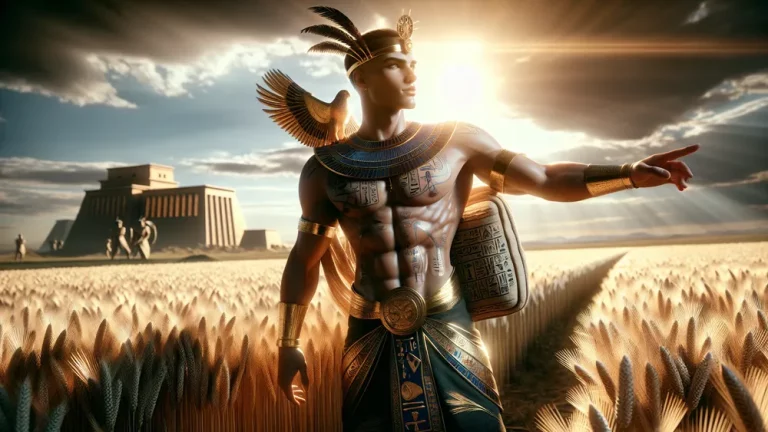Nymphe In Greek Mythology: Nature Spirits And Their Roles
Greek myths give a clear image of gods, humans, and creatures that influenced Western ideas and symbols. Among them, nymphs appear as unique spirits tied to nature, reflecting the beauty and strength of the world itself. They are connected to things like rivers, forests, and mountains, acting as protectors and symbols of these places.
Key Points:
- Nymphs are part-natural spirits tied to places like rivers, forests, and mountains.
- They are not fully gods but live long lives and have powers connected to nature.
- Different types of nymphs exist: Naiads (freshwater), Dryads (trees), Oreads (mountains), Oceanids (seas), and more.
- Famous myths include Daphne turning into a tree, Echo losing her voice, and Calypso holding Odysseus on her island.
- Nymphs often defend nature and punish those who cause harm to their surroundings.
- Their powers include healing, inspiration, transformation, and protecting their homes.
- They symbolize a mix of human struggles and natural harmony in Greek mythology.
But, they don’t rule like the powerful gods of Olympus, who control the big and important parts of life. Instead, nymphs act as go-betweens for the godly and the human, placing them somewhere in the middle. Though they don’t seem all-powerful, they still hold a strong presence in the places they stay. They connect people to nature.
This part-human and part-divine side of nymphs makes them interesting. They are easier to relate to because their struggles feel familiar. At the same time, their connection to gods makes people admire them. Nymphs don’t command armies or control the grand skies. But their ability to suggest that nature holds strength, even if it is quiet, feels important.
Learning more about their roles and stories gives us a better understanding of just how much ancient Greeks respected nature and the life tied to it. These beliefs became the basis of their myths and art.
Nymphe: Overview and Key Facts
| Aspect | Key Information |
|---|---|
| Definition | Nymphs are partly god-like spirits in Greek myths, each tied to areas of nature like forests, rivers, and mountains. |
| Etymology | The term “nymph” (νύμφη) in Greek meant “bride” or “young woman.” It was tied to youth, natural beauty, and the ability to give life. |
| Nature and Status | Neither purely mortal nor fully divine, nymphs live long and have powers tied to their places. They do not have the full power of gods. |
| Connection to Nature | Nymphs are deeply connected to aspects of nature. They protect the forests or rivers they are linked to, serving as symbols of these places. |
| Hierarchy | Below the Olympian gods in power, nymphs help them in many ways. Artemis, for instance, is often accompanied by them as helpers. |
| Roles in Mythology | Nymphs take care of nature. They also play roles in myths as romantic figures or as characters who challenge others. |
| Famous Types | There are different types such as Naiads for freshwater, Dryads for trees, and Oreads for mountains. Each group has its own role in myths. |
| Symbolism | Nymphs stand for natural beauty, fruitfulness, and nature’s special value. They remind people of the link between humans and the environment. |
| Cultural Reverence | Ancient Greeks gave offerings to nymphs at springs, groves, and caves. This was because of their role as nature’s protectors. |
| Prominent Myths | Nymphs play roles in stories like Daphne’s change into a tree, Echo’s fate, and Calypso keeping Odysseus on her island. |
Who Are Nymphs in Greek Mythology?
To really understand what nymphs are, it is necessary to look at their beginnings, their role in Greek myths, and the many ways they connect with nature. These ideas can be looked at more closely in the next parts.
Where Did Nymphs Come From?
The beginnings of nymphs in Greek myths come from the earliest forces of the world. These forces include things like earth, water, air, and life itself. Nymphs are tied to nature and were thought to come from these great, old powers. They represent both the physical and spiritual sides of nature.
For instance, many water nymphs, including Naiads who live in freshwater, are said to come from Oceanus and Tethys. These two Titans represent rivers and seas. Similarly, the tree nymphs called Dryads are often seen as the children of Gaia, the Earth itself, making them literal parts of the land. The connections between nymphs and their environments are clear. They show how these beings are part of nature itself.
Still, myths give no single explanation for how nymphs were created. Different cities in Greece told different stories about where they came from. While this creates contradictions, it also makes their stories richer and more flexible. People could adjust the myths to match their local lands and beliefs.
Here are some of the gods and natural forces linked to nymphs:
- Oceanus and Tethys: They are the ancestors of water nymphs like the Oceanids (sea nymphs) and the Naiads. These two deities connect to the rivers, streams, and seas.
- Gaia: She is the goddess of Earth and the mother of Dryads and other nymphs of the land. Gaia is seen as the source of life and growth.
- Uranus (Sky): Rare myths link Uranus to nymphs who represent the wind or stars.
- Nyx (Night) and Erebus (Darkness): Some myths say nymphs of caves or twilight come from these deities.
These links to powerful figures in mythology underline the respect Greeks had for nature. Nymphs were often treated as gentle bridges between the human world and the divine, tying together life, gods, and the environment.
Nymphs in Greek myths were seen as nature spirits born from ancient forces like earth, water, and gods, with their origins varying by local traditions.
How Nymphs Fit Into the Greek World
In Greek myths, nymphs have a special role. They connect the gods and humans while also standing for nature’s spirit. Compared to the Olympian gods, who rule things like the sky or war and have far-reaching power, nymphs are only partly divine. They are tied to specific, natural places like rivers, trees, and mountains.
This link means they are easier for people to connect with, but they also depend on these places to survive. If a nymph is separated from their natural home, they cannot live. Often, nymphs are described as companions to gods like Artemis, which shows their lower status. But at the same time, they have great independence.
They guard their special parts of nature and interact with mortals in many ways. Some nymphs, like Naiads (those connected to freshwater), don’t just protect rivers and streams. They also appear in myths as helpers, companions, or even romantic partners for mortal heroes. Because nymphs are partly divine, mortals could speak to and interact with them directly.
This made them different from the Olympian gods, who were more distant and harder to reach. Still, nymphs had a closer connection to the gods because of their sacred purpose: protecting nature. By linking gods, humans, and the environment, nymphs represent the way all three are tied together in Greek mythology.

Types of Nymphs and What They Represent
Nymphs are grouped based on natural spaces they are part of, with each kind connected to a certain feature of the environment. For instance, Naiads live in rivers, springs, and fountains. They represent the way water keeps life going and are seen as protectors of these spaces. Oreads, on the other hand, are nymphs from mountains.
They stand for the rocky heights of the natural world, and being in their space made ancient people feel both wonder and respect. Among tree nymphs, the Dryads, who are tied to trees (especially oaks), are one of the most well-known groups. They represent forests’ living energy, making them symbols of life itself.
Unlike the great gods of Olympus, who control large domains like the sky or war, nymphs remain attached to particular places. This makes them easier to relate to but also means they cannot live away from these spots. Still, not all groups of nymphs fit into clear categories.
Greek myths often mix up aquatic nymphs, like Oceanids and Naiads, or blend spirits of land and water. These differences depend on where each myth comes from.

The table below explains the main types of nymphs, their natural spaces, and what makes each important:
| Type of Nymph | Natural Space | Main Role | Known Stories |
|---|---|---|---|
| Naiads | Freshwater | Care for rivers, lakes, and springs; represent water’s importance. | The escape of Arethusa from Alpheus. |
| Dryads | Trees and Forests | Linked to trees; protect forests and live as long as their tree. | Eurydice and her ties to wooded areas. |
| Oreads | Mountains | Represent the wildness and power of rocky terrain. | Often join Artemis on her mountain hunts. |
| Oceanids | Oceans and Seas | Connected to salty waters and watch over marine life. | Daughters of Oceanus, such as Calypso in The Odyssey. |
| Limnades | Lakes | Live in calm lakes, watching over quiet water bodies. | Rarely mentioned but valued in small lake regions. |
| Hesperides | Garden of the West | Take care of golden apples; connected with the evening. | Featured in Heracles‘ eleventh labor. |
This list explains how nymphs connect to nature and their roles as caretakers of the world. Each type of nymph not only represents something physical but also reflects how much the Greeks valued their natural surroundings.
Popular Myths Involving Nymphs
Nymphs are found in many Greek myths. They help create stories that focus on their charm, sadness, and ties to nature. Some of their stories are about beauty. Others include sorrow or danger. Here are some of the most famous tales where nymphs play a key part.
The Story of Daphne: The Nymph Who Became a Tree
The story of Daphne is a moving one. It tells how a nymph struggled to keep her independence from divine forces that tried to control her. Daphne, a Naiad (a freshwater nymph), was famous for both her beauty and her graceful nature. According to Ovid’s Metamorphoses, these traits caught the eye of Apollo, the god of the sun and poetry.
But Daphne had made an oath to follow Artemis, the goddess of chastity, and to remain a virgin for her entire life. Apollo’s feelings for Daphne were not natural. His love came from a fight with Cupid, who shot him with a golden arrow to make him fall in love. At the same time, he struck Daphne with a lead arrow to fill her heart with dislike.
Because of this, Apollo chased her with passion, and she fled with fear and disgust. This conflict shows the struggle between the wishes of gods and the freedom of mortals, something found in many Greek myths. When Apollo got close to Daphne and she realized she could not escape, she turned to her father, the river god Peneus, and begged him to save her.
He answered her prayer by changing her into a laurel tree. As she transformed, her hands became branches, her feet grew into roots, and her hair changed into leaves. Apollo was heartbroken. He could not undo her transformation, so he made the tree sacred. He wore its branches and declared that the laurel would always be a symbol of victory and poetic talent.
This story is both sad and important. Daphne lost her physical freedom, but through her transformation, she gained independence and became connected to nature forever.

Here are key themes and symbols from her story:
- Chastity and Freedom: Daphne’s refusal to submit to Apollo shows her commitment to her independence.
- Change and Escape: Her transformation into a tree was her only way to escape Apollo.
- The Laurel Tree: Apollo made the laurel sacred, and it became a symbol of success in poetry and sports.
- Power Imbalance: The myth highlights how mortals and gods had unequal power, but Daphne’s change was an act of defiance.
This myth demonstrates Daphne’s lasting impact on Greek culture, where the laurel remains a powerful symbol of success and endurance.
Echo’s Tale: The Nymph Who Lost Her Voice
Echo, a mountain spirit (or Oread), is remembered as one of Greek mythology’s most tragic figures. She is known for her encounters with Hera and her one-sided love for Narcissus, a mortal man. Echo had a captivating voice and a skill for telling stories. Her charm let her influence and impress people. But her gift caused trouble when she angered Hera, the queen of the gods.
Echo’s downfall began when she helped Zeus, Hera’s husband, hide his affairs. Hera realized what had happened. Furious, she punished Echo with a cruel curse. Hera made it so that Echo could no longer speak for herself. She could only repeat what others said to her. This curse left her powerless, especially because her voice had been such a critical part of who she was.
Later, Echo’s sadness grew when she fell in love with Narcissus, a man known for his remarkable beauty but also his selfishness. Narcissus rejected everyone who loved him and cared only about himself. When Echo tried to tell him how she felt, her curse got in the way. She could only repeat his own words back to him.
He misunderstood her, mocked her, and left. After this, Echo, heartbroken and humiliated, slowly disappeared. In some versions of the myth, she wasted away from both sadness and shame until nothing was left of her except her voice, which still echoes in mountains and caves today. Narcissus, meanwhile, became obsessed with his reflection in a pool and died staring at his own image.
This story reflects themes of rejection and pride:
- Loss of Individuality: Hera’s curse took away Echo’s personal freedom, silencing the identity she had in her voice.
- Unreturned Love: Echo’s feelings for Narcissus portray the pain of loving someone who does not love you back.
- How Echoes Began: The myth explains how the sound of echoes came to exist in caves and mountains.
- Vanity’s Consequences: Narcissus’ selfishness contrasts with Echo’s quiet suffering, and his obsession led to his downfall.
Echo’s story is both sad and memorable. Her name is still used today, as “echo” refers to the lingering sound that was all she left behind.
Calypso and Her Island: A Love Story of Isolation
Calypso, a nymph of unknown origins and most often called one of Atlas’s daughters, is a central figure in Homer’s Odyssey. She lives alone on Ogygia, a distant island surrounded by the sea. The island is beautiful, but it also feels remote and empty. One day, Odysseus, the king of Ithaca, ends up there after Poseidon destroys his ship.
On the island, Calypso takes him in. She looks after him carefully, giving him shelter and helping him recover from his injuries. Calypso falls deeply in love with Odysseus. She wants him to stay with her forever and even offers him immortality so he won’t ever die. For seven years, he lives on the island with her.
Even though she takes good care of him, Odysseus cannot forget Penelope, his wife in Ithaca, or the home he left behind. Calypso’s role is complicated: she saves Odysseus’s life, but she also keeps him trapped. Her love is not freely given because she forces Odysseus to stay, creating a conflict between love and control. The gods eventually tell Calypso that she has to let Odysseus go.
Zeus, through Hermes, commands her to set him free. Calypso, upset but unable to argue with the gods, gives Odysseus the materials he needs to build a raft and leave. She watches as he sails away, crying because she knows he will never return.
Calypso’s story is rich with themes:
- Freedom and Isolation: Her island is both a paradise and a prison, where Odysseus feels trapped.
- Unreciprocated Love: Calypso’s feelings for Odysseus are not returned in the same way.
- Letting Go: Her decision to release Odysseus shows the difficulty of giving up something you love.
Calypso rescues and cares for Odysseus on her isolated island, but her love becomes a trap until the gods force her to let him go, leaving her heartbroken.
Symbolism and Powers of Nymphs
In Greek mythology, nymphs are often thought of as caretakers of the natural world. They play important roles as otherworldly creatures with special abilities and deeper meanings linked to the earth. Let’s take a closer look at what makes them unique and what they stand for.
Protectors of the Natural World
In Greek mythology, nymphs were respected as protectors of nature. They worked to protect rivers, trees, springs, and other features of the landscape from damage or neglect. Dryads cared for specific trees. If a tree died, the Dryad would also lose her life because the two were connected.
Naiads, on the other hand, watched over freshwater sources, ensuring these waters stayed clean and safe for both gods and people. In myths, nymphs often acted to punish those who harmed nature. Arethusa, a spring nymph, escaped the river god Alpheus by turning into a sacred spring. Her transformation not only saved her life but also made the spring sacred forever, tied to the nymph who became part of it.
These stories show how closely nymphs were linked to their environment. Their own existence depended on keeping their surroundings unharmed. The role of nymphs reflects respect for the natural world and its protection, an idea still important today.

What Nymphs Can Do: Their Special Powers
Nymphs were respected not just for their link to nature but also for their unusual abilities, which were tied to the places they lived. One of their most important powers was the ability to heal and restore. Naiads, freshwater nymphs, were connected to special springs that people believed could cure illnesses and bring renewal.
A person bathing in a Naiad’s spring might find relief from physical or emotional pain. These myths carried the idea that water had the power to heal. Some nymphs were known for inspiring creativity in poets, artists, and musicians. Even though Muses, who had a similar role, are often considered separate, they also connected divine inspiration to nature.

Nymphs, by being tied to natural elements, represented life and growth as well as how the environment could change and bring new energy. Nymphs also had more mystical powers. For example, river nymphs like Peneus in the story of Daphne were believed to sense danger and warn others. Transformation was frequently part of their stories.
Sometimes they changed themselves – like Daphne, who became a laurel tree to avoid Apollo. Other times, they caused changes in their surroundings, such as Arethusa, who became a spring to escape Alpheus. Nymphs were not always gentle. They could punish anyone who harmed their sacred spaces. In stories, they worked with gods to retaliate against those who caused destruction.
Here are some of the powers nymphs were known for:
- Healing and Renewal: Springs and rivers linked to nymphs were believed to have the power to cure.
- Inspiration: Creativity in the arts was often connected to nymphs.
- Foresight and Warnings: Some nymphs could sense dangerous events before they happened.
- Transformation: They could change their own form or transform part of their environment.
- Punishment: Nymphs defended nature by bringing punishment to those who disrespected it.
Nymphs and Their Struggles: Freedom or Control?
In Greek myths, nymphs are described as living lives caught between freedom and being under control. Although they had a connection to the natural world that gave them strength, this bond often limited their independence. For instance, Dryads were tied to their trees, and Naiads depended on their rivers. This relationship with their surroundings was both a strength and a problem. Take Daphne, a river nymph.
She asked her father, the river god Peneus, to save her from Apollo, who was chasing her. Her prayer led to her being turned into a laurel tree. This transformation gave her freedom from Apollo, but at the cost of being tied forever to the form of the tree. A different story, about Calypso, shows something similar but in another way.
As the nymph of the lonely island Ogygia, she loved Odysseus and even offered to give him immortality to stay with her. But she could not leave her island, and her life was shaped by her exile, ordered by the gods. These stories explain something often seen in Greek mythology.
Nymphs, though powerful in some ways, were often held back by stronger forces, whether these were gods or the rules of nature. Their lives meant trying to find a balance between independence and control.
Pantheon of Greek Natural and Abstract Forces
In Greek mythology, the forces of nature and ideas weren’t thought of as inactive parts of the world. Instead, these forces were considered living powers. They were active, and they shaped the universe and affected the way people lived. The Greeks connected these forces to divine beings, either as gods or spirits, who represented ideas like love, the earth, the night, and even conflict.
Figures like Gaia, representing the Earth, and Nyx, standing for the Night, were seen as very old and important. They were part of the first stories explaining how the world began and how the Greeks thought life worked. These ancient figures were central to the Greeks’ understanding of existence as a whole. The Greeks believed that even things like ideas could have divine power.
Their gods and spirits didn’t just represent things you could touch, like the land or the sea, but also more abstract ideas, like love or struggle. The range of these powers was wide, and together they explained how everything in life was connected.
To learn more about these gods and spirits, you can check out this greek Abstract and Natural Forces list, which explains their names, what they were linked to, and their stories. These forces help us understand how the Greeks thought – where even ideas and nature were seen as having their own lives.
FAQs
1. Are Nymphs Truly Immortal in Greek Mythology?
Nymphs in Greek mythology are not truly immortal but possess extraordinarily long lifespans and can perish under specific circumstances.
2. How Are Nymphs Different from Lesser Gods?
Nymphs are different from lesser gods because they are bound to specific natural locations, have limited powers, and lack the broader authority of minor deities.
3. What Are Some Rarely Discussed Nymph Myths?
Some rarely discussed nymph myths include tales like that of Creusa, who secretly bore a child with Apollo and sought to protect him from the world.
4. Do Nymph Origins Reflect Greek Environmental Values?
Nymph origins reflect Greek environmental values by symbolizing the personification of natural elements and humanity’s reverence for the natural world.






